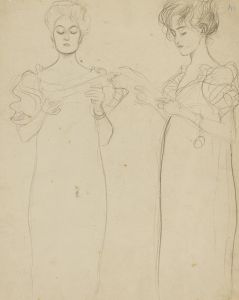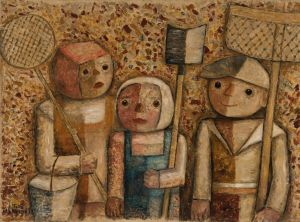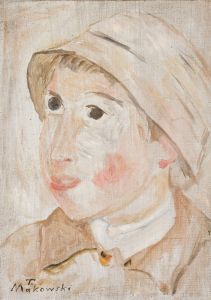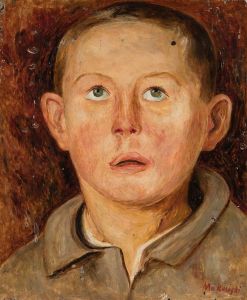
Girl with a canary
A hand-painted replica of Tadeusz Makowski’s masterpiece Girl with a canary, meticulously crafted by professional artists to capture the true essence of the original. Each piece is created with museum-quality canvas and rare mineral pigments, carefully painted by experienced artists with delicate brushstrokes and rich, layered colors to perfectly recreate the texture of the original artwork. Unlike machine-printed reproductions, this hand-painted version brings the painting to life, infused with the artist’s emotions and skill in every stroke. Whether for personal collection or home decoration, it instantly elevates the artistic atmosphere of any space.
Tadeusz Makowski was a Polish painter known for his unique style that combined elements of folk art, symbolism, and modernism. He was born on January 29, 1882, in Oświęcim, Poland, and later moved to Paris, where he spent a significant portion of his career. Makowski's work often depicted scenes of everyday life, children, and rural landscapes, characterized by a distinct use of color and form.
"Girl with a Canary" is one of Makowski's notable works, reflecting his fascination with childhood innocence and simplicity. The painting portrays a young girl holding a canary, a common motif in art symbolizing freedom, joy, and the delicate nature of life. Makowski's depiction of the girl and the bird is rendered with a gentle and tender approach, emphasizing the emotional connection between the two subjects.
Makowski's style in "Girl with a Canary" is marked by his use of soft, muted colors and simplified forms, which are typical of his broader body of work. His approach often involved a blend of realism and abstraction, allowing him to capture the essence of his subjects while imbuing them with a sense of whimsy and wonder. This particular painting is an excellent example of how Makowski's art bridges the gap between traditional and modernist techniques, creating a timeless quality that resonates with viewers.
Throughout his career, Makowski was influenced by various art movements and artists he encountered in Paris, including Cubism and the works of Paul Cézanne. However, he maintained a distinct personal style that set him apart from his contemporaries. His paintings often feature a dreamlike quality, achieved through his use of light and shadow, as well as his ability to convey emotion through minimalistic compositions.
"Girl with a Canary" exemplifies Makowski's ability to capture the essence of childhood with a sense of nostalgia and purity. The painting invites viewers to reflect on the simplicity and beauty of everyday moments, a recurring theme in Makowski's work. His focus on children and their interactions with the world around them highlights his appreciation for the innocence and curiosity inherent in youth.
Makowski's contributions to the art world have been recognized for their unique blend of styles and emotional depth. His works are held in various collections and museums, showcasing his impact on both Polish and international art. "Girl with a Canary" remains a testament to his skill in portraying the subtleties of human emotion and the beauty of ordinary life.
Despite his relatively modest fame during his lifetime, Tadeusz Makowski's work has gained appreciation over the years, with art historians and enthusiasts recognizing the significance of his contributions to modern art. His paintings continue to be studied and admired for their innovative approach and the timeless quality they possess.
In summary, "Girl with a Canary" is a quintessential example of Tadeusz Makowski's artistic vision, capturing the delicate interplay between innocence and experience. Through his masterful use of color, form, and composition, Makowski invites viewers to explore the world through the eyes of a child, finding beauty in the simple and the everyday.


















